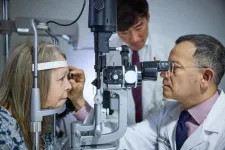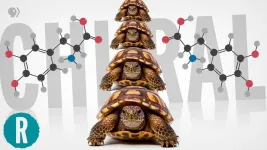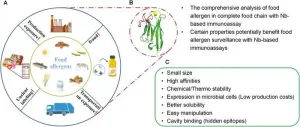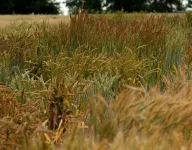(Press-News.org) Roughly 50 families scattered across the world share ultra-rare variants in a particular gene. Silent for years, the inherited mutations make themselves known when patients reach the fourth decade of life. Changes in vision start a cascade of symptoms. Five to 20 years later, the illness is fatal.
Researchers at Washington University School of Medicine in St. Louis have dedicated many years to understanding the rare condition known as retinal vasculopathy with cerebral leukoencephalopathy and systemic manifestations, or RVCL-S, with the aim of developing a treatment for it. In a new study, the team reports that a drug approved by the FDA for another condition may stabilize vision for patients with RVCL-S.
“Fifty percent of family members with these genetic mutations will inherit the disease,” said the study’s co-senior author, Rajendra S. Apte, MD, PhD, the Paul A. Cibis Distinguished Professor of Ophthalmology & Visual Sciences. “These families are devastated by this illness, and we have not been able to offer them much hope. However, our new findings suggest that an already approved medication for a different disease may have the potential to help these patients, although additional studies are needed.”
The study is published June 17 in The Journal of Clinical Investigation.
RVCL-S is marked by progressive vision loss, cognitive decline, dementia and mini strokes, among other neurological manifestations. In the 1980s, two physicians from Washington University initially linked the symptoms to compromised small blood vessels that cause loss of blood flow to retinal, brain, kidney and liver tissues.
“Imagine a traffic jam,” explained first author Wilson Wang, who paused his medical training to pursue independent research in Apte’s laboratory as part of a program at Washington University. “Small blood vessels are the roads feeding into the circulatory highway system. When blood flow trickles, oxygen and nutrients cannot reach the tissue, and damage ensues.”
[caption id="attachment_126401" align="alignnone" width="700"] Wilson Wang, a Washington University medical student enrolled in Washington University’s year-long MD5 program, talks with clinical trial participant Patricia Collins before an appointment to check her vision. As part of his independent research project in the laboratory of Rajendra S. Apte, MD, PhD, Wang studied the effect of the drug crizanlizumab on small blood vessels.[/caption]
Other diseases cause similar circulatory system traffic jams. For instance, blockages in small blood vessels are responsible for episodes of excruciating pain in sickle cell disease. Because there is an FDA-approved drug – crizanlizumab – used to help alleviate pain by unclogging congested small blood vessels and preventing blood cells from sticking to the vessel walls in sickle cell anemia patients, co-senior author Andria L. Ford, MD, a professor of neurology and of radiology, launched a clinical trial to test the drug in RVCL-S patients. A collaboration with Apte – an expert in retinal vascular diseases such as diabetic retinopathy and macular degeneration, conditions affecting blood vessels in the retina – focused on patients’ vision, retinal structure and function.
The researchers set out to see if crizanlizumab helps to improve blood flow in the eyes and brain, explained Ford, who is co-director of Washington University’s RVCL Research Center and senior investigator on a parallel study looking at crizanlizumab’s effect on brain lesions in the clinical trial participants.
Eleven RVCL-S patients – who traveled from as far as California despite the challenges of their health and the COVID-19 pandemic – participated in the clinical trial for two years. They received two doses of crizanlizumab in the first month, followed by subsequent monthly infusions.
Images of retinal blood vessels highlighted with fluorescein dye were obtained at baseline and after the first and second years of the study. Wang and Apte, along with colleagues including Dan Spiegelman, a rising third-year medical student, and P. Kumar Rao, MD, a professor of ophthalmology & visual sciences and vice chair of clinical affairs, analyzed the images and compared them with images taken before the patients were treated with the drug. They calculated the amount of space lacking blood flow in a defined region of the retina, a measurement referred to as the nonperfusion index.
After two years on the drug, trial participants saw their nonperfusion indexes plateau, a sign that loss of small blood vessel integrity was slowing, the researchers explained. Routine eye exams revealed that the participants' vision had stabilized.
Preserving vision in a disease that often ends in blindness has the potential to give patients additional years to read, drive and enjoy activities that bring them happiness. But future studies are needed to test the drug’s ability to slow vision loss in RVCL-S. In a parallel study, the researchers will examine the medication’s impact on brain lesions. If blood vessel blockages in the retina correlate with the brain lesions in these patients, the retina could be used as a biomarker for the systemic disease, Apte explained.
“Until we have a genetic cure, our patients need treatments that halt or slow the progression of the illness,” Ford said. “Washington University is at the forefront of RVCL-S research. Decades of dedication have paved the way for this clinical trial. It represents our commitment to finding treatments that can alter the course of the fatal, rapidly progressing illness.”
Four decades of dedication
Before RVCL-S was identified, patients with the disorder sought answers at Washington University in the 1980s. Seven people, six from one family, were suffering from mysterious neurological symptoms with no known cause. Seven years of inquiry by Washington University physicians led to a published description of the illness, giving their patients a name for their ailments.
Since then, a robust research infrastructure and strong clinical innovation have supported the university’s dedication to understanding and treating the devastating condition.
In 2007, John P. Atkinson, MD, the Samuel B. Grant Professor of Clinical Medicine and one of the key researchers who helped demystify the disease, identified its root cause: mutations in the TREX1 gene. His discovery enabled the development of genetic testing that now gives patients definitive diagnoses. He went on to help establish the university’s RVCL Research Center in 2016, after a $4.1 million donation by Robert Clark and his partners at Clayco – a construction firm in St. Louis – in honor of Clark’s wife who died from the illness at age 50. Two years later, Atkinson led the first clinical trial for RVCL-S.
Although that trial did not show a benefit to patients, the pursuit of treatments for RVCL-S patients has continued.
“We have come a long way with learning about and diagnosing RVCL-S in the last four decades,” Ford said. “But our work doesn’t stop here. More patients have been identified throughout the world, making it possible for other centers to open and bring attention to the rare disease. By working together, we can make a larger impact by increasing the sample size in research studies and finding treatments.”
END
Repurposed drug may help stabilize vision in rare disease
Clinical trial for RVCL-S patients tests drug already approved as sickle cell disease treatment
2024-06-17
ELSE PRESS RELEASES FROM THIS DATE:
Face screening tool detects stroke in seconds
2024-06-17
A new smartphone face-screening tool could help paramedics to identify stroke in seconds – much sooner and more accurately than is possible with current technologies.
Strokes, which affect millions of people globally, occur when the blood supply to part of the brain is interrupted or reduced, which prevent brain tissue from getting oxygen and nutrients. A few minutes of delay can result in permanent damage to the brain cells.
A team of biomedical engineers at RMIT University developed the AI capabilities behind the software technology and has published their results ...
Making this Parkinson's drug is just turtles all the way down (video)
2024-06-17
WASHINGTON, June 17, 2024 — L-DOPA is the best drug we have for Parkinson’s disease, but its molecular mirror image, D-DOPA, causes dangerous side effects. Making L-DOPA without also making D-DOPA is surprisingly hard and requires a specific kind of molecule to pull off. But that specific molecule must be made from a different and equally specific molecule. In this video, our host, George Zaidan, explains how one of the winners of the 2001 Nobel Prize in Chemistry pulled it off, and why "chiral synthesis," as it's called, is really just turtles all the way down. https://youtu.be/_cb09XB07LQ?si=BuMEI5fOuHmuQlkZ
Reactions is a video series ...
Camelid nanobodies: Transforming food allergen analysis
2024-06-17
Recent advancements show nanobodies from camelid antibodies excel in food allergen detection with superior stability, specificity, and cost-effectiveness. This innovative approach aims to improve accuracy and efficiency, crucial for preventing severe allergic reactions. The study highlights nanobodies' potential in reliable immunoassays, addressing rising food allergies and enhancing safety measures.
Food allergies pose significant health risks, affecting millions worldwide, with the prevalence rising over the past decades. Traditional detection methods, such as monoclonal and polyclonal antibodies, are often costly, labor-intensive, and prone to cross-reactions. The need for ...
Federal study examines care following nonfatal overdose among Medicare beneficiaries; identifies effective interventions and gaps in care
2024-06-17
Researchers from the Substance Abuse and Mental Health Services Administration (SAMHSA), the National Institutes of Health’s (NIH) National Institute on Drug Abuse (NIDA), Centers for Medicare & Medicaid Services (CMS), and the Centers for Disease Control and Prevention (CDC) found that among a cohort of 137,000 Medicare beneficiaries who experienced a nonfatal overdose in 2020, almost 24,000 (17.4%) experienced a subsequent nonfatal overdose, and about 1,300 (1%) died from overdose in the following year. Results were published today in JAMA Internal Medicine, identifying both effective interventions and significant gaps in care.
“People who have experienced ...
Maternal inheritance of Alzheimer’s disease tied to increased risk of developing disease
2024-06-17
KEY TAKEAWAYS
Mass General Brigham researchers analyzed 4,400 cognitively unimpaired adults with amyloid imaging, finding increased amyloid in those who reported that their mothers had symptoms of Alzheimer’s disease (AD).
Increased amyloid, a biomarker of AD, was also found in those with a history of the disease on both sides of their family and in those whose fathers had an early onset of symptoms.
The study suggests that a person’s maternal versus paternal family history could ...
Epidemiologic features of recovery from SARS-CoV-2 infection
2024-06-17
About The Study: More than 1 in 5 adults did not recover within 3 months of SARS-CoV-2 infection in this cohort study. Recovery within 3 months was less likely in women and those with preexisting cardiovascular disease and more likely in those with COVID-19 vaccination or infection during the Omicron variant wave.
Corresponding Author: To contact the corresponding author, Elizabeth C. Oelsner, M.D., M.P.H., email eco7@cumc.columbia.edu.
To access the embargoed study: Visit our For The Media website at this link https://media.jamanetwork.com/
(doi:10.1001/jamanetworkopen.2024.17440)
Editor’s Note: Please see the article for additional information, ...
Electronic cigarettes vs varenicline for smoking cessation in adults
2024-06-17
About The Study: This randomized clinical trial found that varenicline and nicotine-containing electronic cigarettes were both effective in helping individuals in quitting smoking conventional cigarettes for up to 6 months.
Corresponding Author: To contact the corresponding author, Anna Tuisku, Ph.D., email anna.tuisku@lapha.fi.
To access the embargoed study: Visit our For The Media website at this link https://media.jamanetwork.com/
(doi:10.1001/jamainternmed.2024.1822)
Editor’s Note: Please see the article ...
Risk factors for long COVID revealed
2024-06-17
NEW YORK, NY (June 14, 2024)--Early in the pandemic, many people who had SARS-Cov-2 infection or COVID-19 began to report that they couldn’t shake off their symptoms even after a month or more—unusually long for a viral infection of the upper respiratory tract—or developed new, persistent symptoms soon after the infection cleared.
Although it’s still not clear what causes post-COVID-19 conditions or “long COVID” (symptoms and conditions that develop, linger, or reoccur weeks or months after SARS-CoV-2 infection), a new study by researchers at Columbia University Vagelos College ...
Ancient polar sea reptile fossil is oldest ever found in Southern Hemisphere
2024-06-17
An international team of scientists has identified the oldest fossil of a sea-going reptile from the Southern Hemisphere – a nothosaur vertebra found on New Zealand’s South Island. 246 million years ago, at the beginning of the Age of Dinosaurs, New Zealand was located on the southern polar coast of a vast super-ocean called Panthalassa.
Reptiles first invaded the seas after a catastrophic mass extinction that devastated marine ecosystems and paved the way for the dawn of the Age of Dinosaurs almost 252 million years ago. Evidence for this evolutionary milestone has only been discovered in a few places around the world: on the Arctic island of Spitsbergen, northwestern North ...
Finding hidden genetic treasure: Study uncovers untapped diversity in historic wheat collection
2024-06-17
A decade-long collaborative study has discovered huge genetic potential that is untapped in modern wheat varieties.
The international study which appears in Nature reveals that at least 60% of the genetic diversity found in a historic collection of wheat is unused providing an unprecedented opportunity to improve modern wheat and sustainably feed a growing global population.
To make this discovery, a cross-institutional collaboration led by Dr Simon Griffiths, at the John Innes Centre and Professor Shifeng Cheng at the Agricultural Genomics Institute at Shenzhen, Chinese Academy of Agricultural Sciences (CAAS), studied the A.E. Watkins Landrace Collection, a ...
LAST 30 PRESS RELEASES:
For teens, any cannabis use may have impact on emotional health, academic performance
School meals could unlock major gains for human and planetary health
Menopause hormone therapy does not appear to impact dementia risk
Signature patterns of brain activity may help predict recovery from traumatic brain injury
Dresden study uncovers new key mechanism in cancer cells
New species are now being discovered faster than ever before, study suggests
Cannabis-based products show limited short-term benefit for chronic pain, with increased risk of adverse effects
Cannabis products with more THC slightly reduce pain but cause more side effects
Clearing the brain of aging cells could aid epilepsy and reduce seizures
Brain injuries linked with potential risk of suicide, new study finds
New technique lights up where drugs go in the body, cell by cell
New study finds movement of fishing fleets can reveal shifts in marine ecosystems
Embargoed: New evidence points to potential treatment for vascular dementia
Study uncovers disrupted brain balance in alcohol dependence
Working in groups can help Republicans and Democrats agree on controversial content moderation online
Structural findings reveal how distinct GPCR ligands create different levels of activation
Anything-goes “anyons” may be at the root of surprising quantum experiments
UC review: Maximizing workplace opportunity for veterans
From generation to complex control: Metasurfaces make perfect vortex beams "within reach"
Thin-film lithium niobate-based detector: recent advances and perspectives
Exploring why some people may tend to persistently make bad choices
How cells balance their protein levels
Nirsevimab vs RSVpreF vaccine for RSV–related hospitalization in newborns
Effectiveness and impact of maternal RSV immunization and nirsevimab on medically attended RSV in US children
AI gives scientists a boost, but at the cost of too many mediocre papers
Next-generation vision model maps tree growth at sub-meter precision
Genes aren’t destiny for inherited blindness, study shows
MIT study: High-fat diets make liver cells more likely to become cancerous
Exposure to multiple fine particulate matter components and incident depression in the US Medicare population
Risk of burdensome health care spending over time in the US
[Press-News.org] Repurposed drug may help stabilize vision in rare diseaseClinical trial for RVCL-S patients tests drug already approved as sickle cell disease treatment







